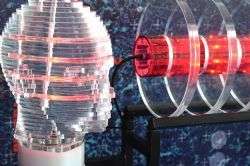Presenting the future of proton therapy

A leading scientist making major strides in medical imaging, which could make proton therapy a viable treatment for many more cancer sufferers, will present his latest findings – including a new type of proton imaging – at a prestigious conference next month.
Professor Nigel Allinson MBE, Distinguished Professor of Image Engineering at the University of Lincoln, UK, will appear among other world-leading experts at the Proton Therapy Congress in London this September.
Proton therapy is a form of radiation treatment that uses protons rather than x-rays to treat cancer. Compared with standard radiation treatment, proton therapy has several benefits, including less radiation damage to the normal healthy tissues around the tumour and potential to deliver a higher radiation dose to the tumour (increasing the chances of destroying tumour cells), and it may result in fewer and less severe side effects such as low blood counts, fatigue, and nausea during and after treatment. Proton therapy is particularly important in treating children.
The NHS will open two new proton therapy centres in the UK in 2018 and many more are being constructed or planned globally, making the implementation of proton therapy a priority for academics and doctors around the world.
The Congress will bring together researchers, clinicians, manufacturers and many more in the proton therapy sector to examine the future of proton therapy. It will take place in London on 20th-21st September 2016.
Professor Allinson, based in the School of Computer Science at the University of Lincoln, leads the groundbreaking PRaVDA (Proton Radiotherapy Verification and Dosimetry Applications) project. He and his multinational team are developing one of the most complex medical instruments ever imagined to improve the delivery of proton therapy.
The PRaVDA instrument is being designed to produce detailed three-dimensional images of a patient's anatomy using protons rather than x-rays, which has never been done before. To produce these Proton CT images, the world-first technology will use the same high energy particles that are used to destroy a tumour during proton therapy treatment.
Using protons to form an image of the patient will greatly improve the accuracy of the treatment. Using current methods, there could be a discrepancy of up to 1cm in terms of where the protons release most of their energy after passing through 20cm of healthy tissue. By using Proton CT, this margin for error can be reduced to just a one or two millimetres.
The PRaVDA researchers believe that Proton CT will soon be used as part of the planning process for cancer patients, as well as during and after treatment.
Professor Allinson said: "Proton therapy is an improved approach for treating challenging tumours especially and it is likely to become the preferred radiotherapy method for most childhood cancers, as the unwanted exposure to radiation of healthy tissue is much reduced and so the risk of second cancers later in life is also lessened.
"Reducing the dose to healthy tissue and planning for optimum treatments are the main underlying advantages of proton therapy, however accurate preparation is absolutely essential to ensure that the dose does not miss the target tumour. This is where PRaVDA comes in, and I am looking forward to presenting our most recent work at the Proton Therapy Congress. Our new imaging method, based on the scattering of the proton, will greatly simplify the instrument and make proton CT even more viable."
The PRaVDA consortium, funded by a £1.8 million translation grant from the Wellcome Trust and led by the University of Lincoln, consists of five UK universities, four UK NHS Trusts and Foundation Trusts, University of Cape Town and IThemba LABS, South Africa, and Karolinska University Hospital, Sweden.
A section of the PRaVDA instrument was recently selected for inclusion in the Institution of Engineering and Technology's new show wall at its Savoy Place headquarters in London, which represents a year-long exhibition celebrating 100 engineering ideas that have changed our world.
PRaVDA has also been shortlisted for The Engineer 'Collaborate to Innovate' Awards, which celebrate the best examples of innovative, technology-led collaborations across the manufacturing industry and academia.


















